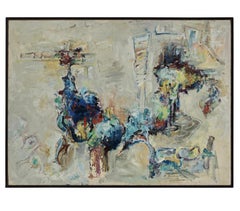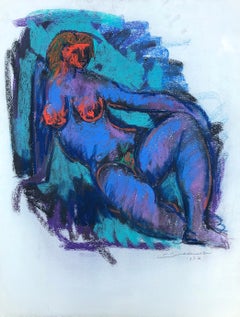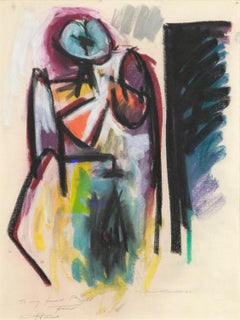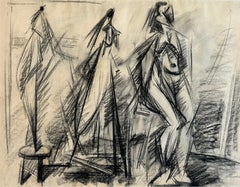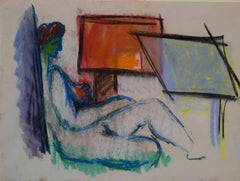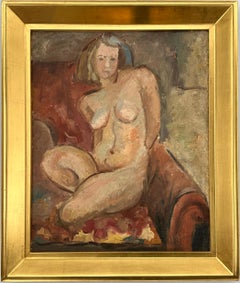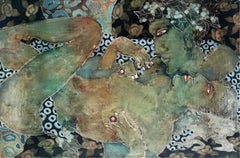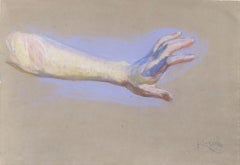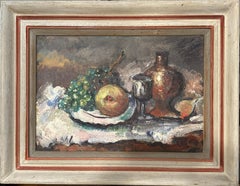Hans Burkhardt Art
Hans Gustav Burkhardt was a Swiss-American abstract expressionist artist. He was born on December 20, 1904, in Basel. Burkhardt’s paintings of the 1930s are part of the genesis of American abstract expressionism. He moved to Los Angeles in 1937 and represented the most significant bridge between New York and Los Angeles. He brought with him many of the nascent ideas of abstract expressionist painting that had been swirling among New York's artists, foremost among them, Arshile Gorky and Willem de Kooning. Working independently in Los Angeles, Burkhardt's experimental investigative approach parallelled and in many instances anticipated the development of modern and contemporary art in New York and Europe. His unique role as an important American painter is affirmed by the constant interest and continuing reassessment afforded his work. In 1992, Burkhardt was honored as the recipient of the Lifetime Achievement Award by the American Academy of Arts and Letters. His works are displayed across many museums, including the British Museum, Metropolitan Museum of Art, Whitney Museum of American Art, Los Angeles Museum of Contemporary Art and Norton Simon Museum. Burkhardt died on April 22, 1994, in Los Angeles.
1970s Abstract Hans Burkhardt Art
Canvas, Oil
1970s Abstract Hans Burkhardt Art
Paper, Pastel
20th Century Post-War Hans Burkhardt Art
Paper, Pastel
1940s Cubist Hans Burkhardt Art
Charcoal
1960s Modern Hans Burkhardt Art
Pastel
1930s American Modern Hans Burkhardt Art
Canvas, Oil
20th Century Post-War Hans Burkhardt Art
Paper, Pastel
1960s Abstract Expressionist Hans Burkhardt Art
Canvas, Oil
Mid-20th Century Hans Burkhardt Art
Oil, Canvas
1930s Modern Hans Burkhardt Art
Canvas, Oil
1970s Modern Hans Burkhardt Art
Paper, Pastel
1980s Abstract Expressionist Hans Burkhardt Art
Lithograph, Linocut
20th Century Post-War Hans Burkhardt Art
Paper, Oil, Monotype
1940s American Modern Hans Burkhardt Art
Lithograph
1960s Hans Burkhardt Art
Acrylic, Paper
1980s Abstract Expressionist Hans Burkhardt Art
Lithograph, Linocut
1670s American Modern Hans Burkhardt Art
Paper, Pastel
1960s American Modern Hans Burkhardt Art
Paper, Pastel
1970s Abstract Hans Burkhardt Art
Paper, Lithograph
1970s Abstract Hans Burkhardt Art
Paper, Lithograph
1970s Abstract Hans Burkhardt Art
Paper, Ink, Watercolor
20th Century Post-War Hans Burkhardt Art
Paper, Mixed Media
1970s Abstract Hans Burkhardt Art
Paper, Pastel
1960s Modern Hans Burkhardt Art
Paper, Pastel
1960s Modern Hans Burkhardt Art
Paper, Pastel
1960s Modern Hans Burkhardt Art
Paper, Pastel
1970s Hans Burkhardt Art
Linocut
1970s Cubist Hans Burkhardt Art
Pastel
1960s Cubist Hans Burkhardt Art
Pastel
1980s Contemporary Hans Burkhardt Art
Paper, Pastel, Watercolor, Gouache
20th Century Hans Burkhardt Art
Paper, Pastel
Mid-20th Century American Modern Hans Burkhardt Art
Canvas, Oil
Mid-20th Century American Modern Hans Burkhardt Art
Canvas, Oil
1940s American Modern Hans Burkhardt Art
Oil, Masonite
2010s American Modern Hans Burkhardt Art
Pastel, Mixed Media, Archival Paper
Early 20th Century Cubist Hans Burkhardt Art
Paper, Charcoal
1940s Cubist Hans Burkhardt Art
Paper, Charcoal
1960s American Modern Hans Burkhardt Art
Canvas, Oil, Cardboard
2010s Contemporary Hans Burkhardt Art
Pastel, Archival Ink, Watercolor, Archival Paper
1970s American Modern Hans Burkhardt Art
Canvas, Oil
1970s Realist Hans Burkhardt Art
Paper, Pastel
Mid-20th Century Modern Hans Burkhardt Art
Oil, Canvas
1970s Abstract Hans Burkhardt Art
Oil, Canvas
1940s Cubist Hans Burkhardt Art
Canvas, Oil
1950s Cubist Hans Burkhardt Art
Pastel
1940s Cubist Hans Burkhardt Art
Pastel
1940s Cubist Hans Burkhardt Art
Pastel
1980s Abstract Expressionist Hans Burkhardt Art
Lithograph, Linocut
1980s Abstract Expressionist Hans Burkhardt Art
Lithograph, Linocut
1980s Abstract Expressionist Hans Burkhardt Art
Lithograph, Linocut
1950s Cubist Hans Burkhardt Art
Pastel
1960s Cubist Hans Burkhardt Art
Pastel
1960s Cubist Hans Burkhardt Art
Pastel
